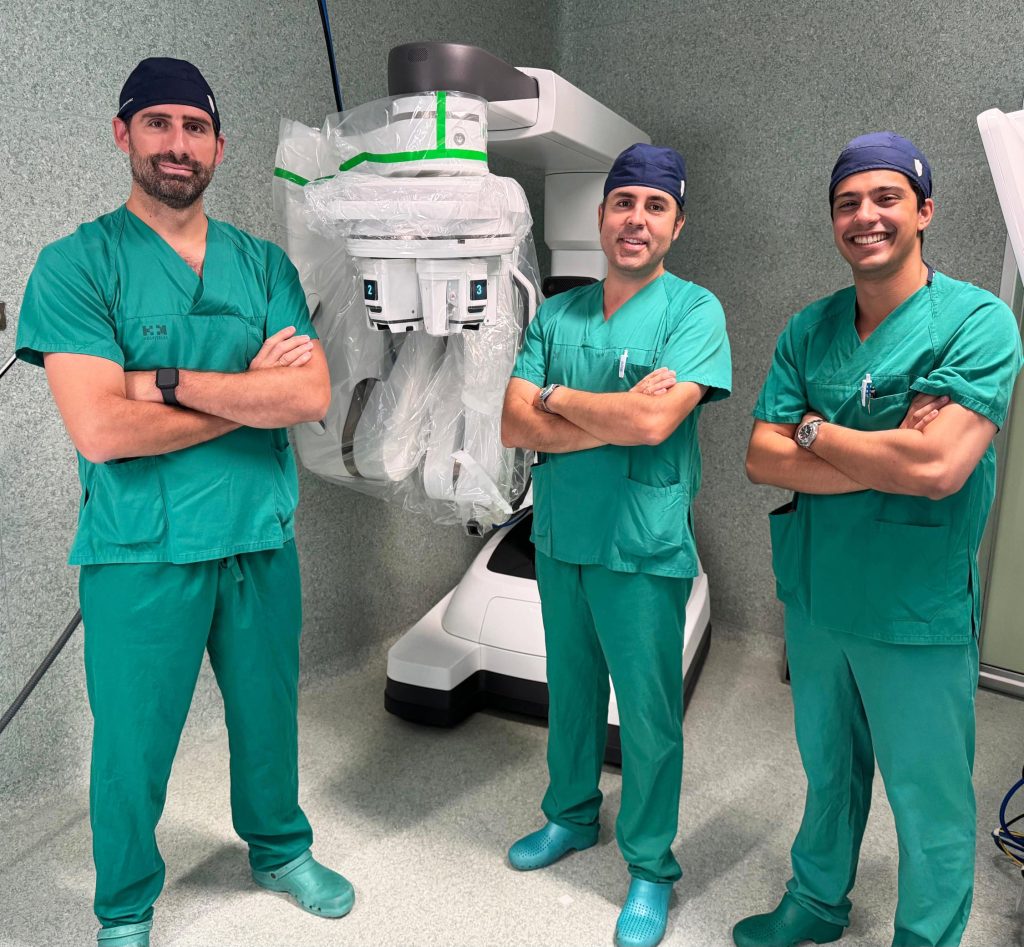Muscle-invasive bladder cancer represents one of the greatest challenges in oncological urology due to its aggressiveness and the surgical complexity involved in its treatment. In this context, HM Hospitales and the urology group ROC Clinic have taken a historic step by performing, for the first time in Spain and the third time in Europe, a robotic radical cystectomy using the da Vinci Single Port system—the most advanced and sophisticated single-port surgical robot currently available—at Hospital Universitario HM Sanchinarro in Madrid. This highly precise, minimally invasive technique marks a new era in urological surgery in our country and positions Spain at the forefront of Europe in the use of this technological platform.
The operation, successfully performed by Dr Ricardo Brime, head of the Robotic Surgery Unit at ROC Clinic, and Dr Vital Hevia, uro-oncology specialist—both from the Urology Department of HM Sanchinarro—represents a turning point in the surgical treatment of muscle-invasive bladder tumours. Carrying out this procedure in Spain places the surgical team among the first in Europe to adopt this technique, which remains uncommon even in reference countries such as the United Kingdom, Portugal, France, or Italy.
Until now, this type of surgery was carried out via open techniques or, more recently, with multiport robotic systems. The introduction of the da Vinci Single Port robot enables the procedure to be performed through a single incision, minimising surgical trauma, reducing postoperative pain, shortening recovery times, and significantly improving the patient experience.
“Performing a radical cystectomy with the da Vinci Single Port pushes minimally invasive surgery to its limits while maintaining extraordinary surgical precision. This system allows us to reach complex anatomical areas through a single access point, using articulated and smaller calibre instruments. It represents a qualitative leap in robotic oncological surgery,” explains Dr Brime, head of the Robotic Surgery Unit at ROC Clinic.
This procedure, along with the first three radical prostatectomies carried out in February this year, places Hospital Universitario HM Sanchinarro and its Urology Unit at the forefront of robotic surgery worldwide. It also exemplifies the hospital’s commitment to technological innovation, medical excellence, and the development of surgical techniques that improve recovery and quality of life for cancer patients. This leading role in global robotics is further supported by the centre’s pioneering robot-assisted laparoscopic surgeries, performed by the General and Digestive Surgery Department and the nation’s first radical mastectomy using the da Vinci SP system.
A revolutionary technique for highly complex surgery
Radical cystectomy involves the complete removal of the urinary bladder in patients with advanced bladder cancer. It is considered one of the most demanding surgeries in oncological urology, involving a long procedure with multiple surgical stages and traditionally posing a challenge even with conventional robotic surgery. Alongside its technical complexity, the procedure requires urinary reconstruction and has a significant systemic impact on the patient.
Thanks to the incorporation of the da Vinci SP robot, this procedure can now be performed through a single incision, transforming the approach in terms of invasiveness, precision, and recovery.
“With the Single Port system, we take minimally invasive surgery one step further. We achieve a more precise procedure with better postoperative outcomes. This translates into less pain, faster recovery, and above all, a significant reduction in complications,” states Dr Ricardo Brime.
Clinical advantages of the da Vinci Single Port (SP) robot
The introduction of the da Vinci Single Port (SP) robot in urological surgery represents an unprecedented clinical and technological breakthrough, especially in highly complex procedures such as radical cystectomy. This innovative technology offers a range of benefits that directly impact patient safety, effectiveness, and recovery.
One of its main strengths is the significant reduction in morbidity, thanks to the robot system’s millimetre-level precision, which avoids damage to adjacent structures and minimises intraoperative complications. This precision optimises control over the surgical field and improves clinical outcomes compared to traditional open surgery.
From the patient’s perspective, this advancement allows the procedure to be carried out through a single incision, resulting in less postoperative pain, faster recovery, and a shorter hospital stay. This minimally invasive approach reduces the physical toll of surgery and enhances the postoperative experience.
Furthermore, the use of a single port enables more efficient urinary reconstruction, as the platform facilitates the complex suturing required for urinary diversion following bladder removal. Finally, the da Vinci SP offers superior oncological precision, allowing for more meticulous dissection of the tumour and lymph nodes—key elements for the safe and effective treatment of invasive bladder cancer.

